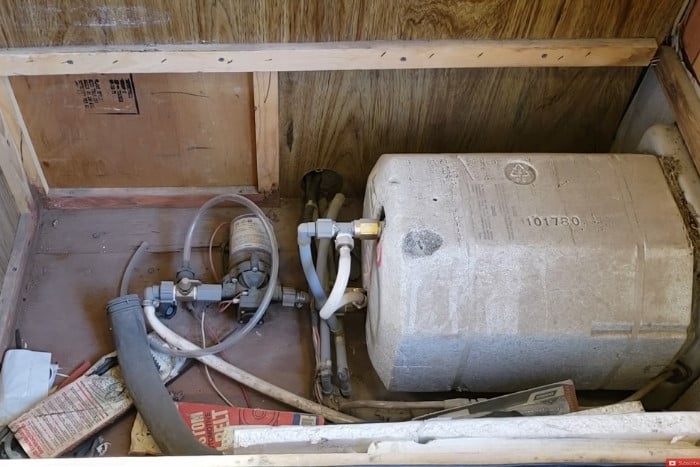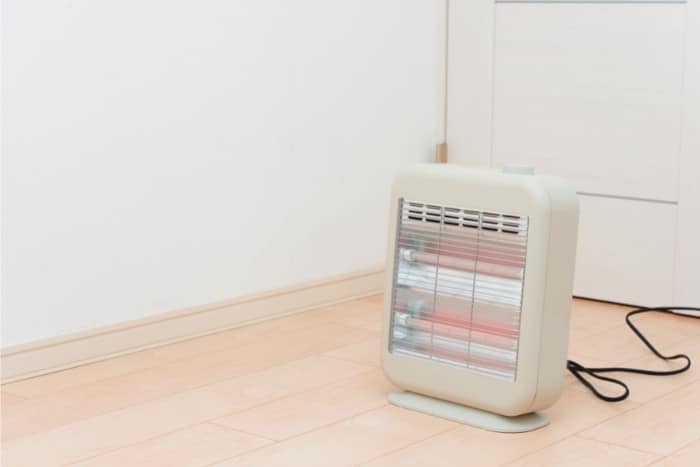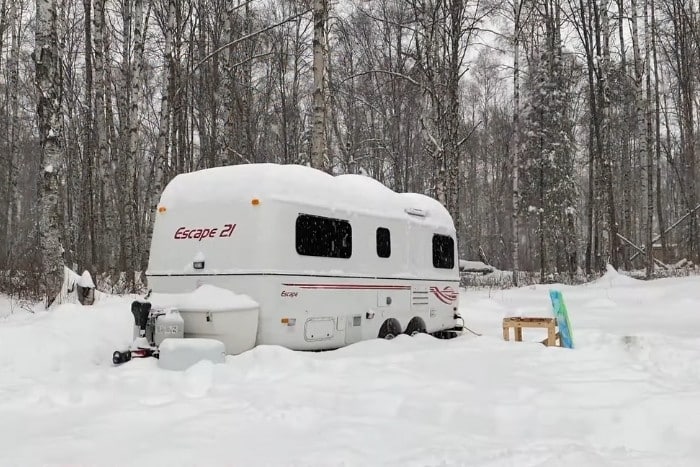Spending winter in your RV can be an exciting experience. However, you may worry about the substantial and expensive risks to your RV piping if you experience freezing conditions. You may wonder how cold you can go before your RV pipes freeze and damage.
It’s difficult to state an absolute temperature at which RV pipes become frozen since it depends on many factors. RV pipes freezing depends on the length of time they are exposed and whether they are used. Insulated pipes also means withstanding much lower temperatures before freezing over.
Before settling in for your winter RV experience, make sure you are aware of the risks to your RV pipes, at what temperature this may become a serious problem, and what you can do to lower the threshold at which your pipes can freeze.
RV Pipes in Freezing Conditions
Before looking into the temperatures and conditions leading to frozen RV pipes, we should first clarify that all vehicles vary. Many are made differently with various adaptations to deal with winter living.
RV owners may have vastly different experiences with their pipelines in lower temperatures, depending on several factors that we will delve into below.
It’s also worth noting that if you winterize your vehicle for storage (or for living in), your RV can also be exposed to much cooler temperatures without the risk of the pipes freezing.
1. Why you need to know when your RV pipes may become frozen
RVing in winter conditions is a consideration for many, especially since many RVs are designed with ‘four season’ adaptations to withstand cooler weather.
As your RV’s plumbing tends to be the most vulnerable part of your vehicle and integral to RV living, it’s important to be aware that pipes can freeze if exposed to temperatures that are too cold for too long.
If this happens, it can lead to uncomfortable living conditions and expensive damage repairs.
Frozen pipelines mean that RV sinks are unusable, and RV owners won’t be able to shower or access their water supply until pipes are thawed out using a heater, heat tape (or a hairdryer), or by calling for professional support.
If pipes become frozen, they can unfreeze and continue to function. However, pipes can be damaged beyond repair if temperatures get too cold.
RVs could have metal or plastic piping, and both of these materials can crack when frozen.
It’s very important to check for fissures or cracks before thawing out your plumbing, or you can encounter serious leaks.

2. Temperature for pipes to freeze
Generally speaking, water begins to freeze at 32F (0 C).
Although it’s unlikely that pipes will freeze for a short time at this temperature, we advise that if you are staying in a location that will drop to this freezing point or below, it’s worth taking precautions to make sure that your pipes don’t freeze, rather than risking this eventuality.
Some full-time RVers are adamant that the real risk of pipes freezing comes when pipes are exposed to temperatures of 20F or below if you are using heat but do not have extra insulation.
Despite the varying levels of success that RV owners have had with their pipes withstanding the cold, it’s always better to be safe and not test the limits of your vehicle at the risk of considerable damage.
3. Time RV pipes need to be exposed to cold temperatures before they freeze
It’s not only the temperature that is important when considering how cold it needs to be to affect your RVs plumbing. When the temperature drops below 32 F, luckily, your pipes won’t instantly freeze over.
Nor will they necessarily freeze overnight since the weather will normally heat up enough during the day, meaning that below-freezing temperatures are only for a few hours at night.
It’s important to note that it usually takes 24 hours of low uninterrupted temperatures for RV pipes to freeze.
If you are only in below-freezing conditions for a short period, your plumbing pipes should be safe from becoming frozen.
However, experienced RV owners also point out that it depends on the nature of the temperature drop.
If the conditions plummet quickly from above freezing to way below, the likelihood of your pipes freezing over quickly before you have time to react is much higher.
4. How cold can ‘four season’ RVs go before they experience frozen pipes?
Some RVs come with a ‘four season’ package, so they are specially adapted with features designed to allow them to be liveable in low temperatures.
These adaptations generally include a heated undercarriage which aims to keep the most exposed part of the vehicle protected from the elements.
Although there may still be some pipes that extend past the heated section of your RV, generally speaking, a specially equipped RV should be able to park up at lower temperatures than a standard one without experiencing any winter-related problems such as frozen pipes.
This means that ‘four season’ RVs should, in theory, be able to go below 32F before encountering issues and may be able to reach below 20F if being lived in and heated.
With additional, easy adaptations that we will consider below, your four-season RV may be able to function in temperatures well below the freezing point.
5. Making RV pipes withstand temperatures below freezing
There are adaptations both to your RV and lifestyle that can lower the threshold at which your RV can get by in winter conditions without experiencing frozen pipes.
Checking weather reports and avoiding long spells of frozen conditions can mitigate the risks of your RV pipes freezing.
However, by taking other steps, you can actively ensure that your pipes do not become frozen until well below the freezing point of water.
An easy, although expensive, step is to keep the RV inside as warm as possible using your choice of electric or propane heater.
To maximize the heating effect on your plumbing system, try opening the doors of cabinets below the sink and keeping the bathroom door open too.
This allows heat circulation from your living space to reach your piping, keeping it warmer and lowering the temperatures your pipes can withstand before freezing.
Naturally, the warmer you keep your living space, the lower the conditions outside your RV pipes can endure.
Some RVers say if you maintain a temperature of 70F inside your living space, you can experience temperatures below 20F before encountering problems with frozen pipes.
Moving water freezes at much lower temperatures. Therefore, running your taps can keep the water in your pipes from freezing.
Be careful not to leave them running on more than a gradual trickle, as you still want to avoid emptying your freshwater tank more than necessary.
Since there is more water in your tanks, and it is generally less vulnerable to freezing than water in your pipes, occasionally using your shower and toilet to get the water flowing through the plumbing also helps reduce the risk of freezing.
Having your RV on the road and moving from location to location can also help maintain your pipes since heat is generated when driving.

6. Changes to make to your RV to lower the temperature at which pipes freeze
You can make adaptations to the vehicle and plumbing system themselves to increase their ability to hold out against freezing weather.
As discussed, some four-season RVs are already adapted to deal with inclement conditions.
However, these adaptations can still provide valuable protection to your plumbing and help all RVs withstand colder temperatures than they would otherwise be able to.
Skirting the underside of your vehicle with a fire-resistant insulating material can provide valuable insulation to any exposed parts, including pipes that are situated in or extend beyond the undercarriage of your RV.
Although expensive, Taylor-made skirting can help protect vulnerable pipes. Skirting can significantly reduce the temperature threshold your pipes can withstand.
Since it reduces cold weather effects on the living space of your RV, skirting also helps you implement the living adaptations we covered above, keeping temperatures inside your vehicle as warm as possible and your pipes at a higher temperature via heat circulation.
Other campers swear by using insulating tape on the pipes themselves. Heat tape has a cable that can measure and detect temperatures and ascertain whether additional insulation is needed.
If temperatures drop, the tape emits heat to the area nearby. Helpfully, the tape automatically senses when the temperatures are warmer and only provides extra heat when needed.
If you wrap heat tape around RV pipes, it can help your plumbing cope with much lower temperatures than they could with no protection.
Although it’s easily available, heat tape needs an electrical supply, so if it is not a viable option, even more, basic measures are open to you.
These include wrapping towels around your pipes to add a basic layer of protection. RV owners have successfully withstood winter conditions even with these simple adaptations.
7. When should you make these adaptations?
It’s important to note that if you leave these adaptations until too late, you may not have enough time to act, and your pipes will freeze over at higher temperatures than would have been the case had you taken precautions earlier.
Generally speaking, you should act before the freezing conditions set in. This is why it’s vital to check weather conditions and be on top of reports of long periods of plummeting temperatures.
8. What if your RV is in storage?
Even if you are not venturing on the road with your RV in cold conditions, you must be aware that your pipes may freeze over and experience serious damage.
Even more so if you are not living in it, keeping water flowing through the pipes, heating the living space, and generating heat through moving the vehicle.
As we have explained, living in your vehicle can help alleviate the worst effects of freezing conditions on your pipes.
RV owners who do not stay in their vehicles during winter should consider ‘winterizing’ their vehicles so that RV pipes do not suffer damage during cold periods.
Winterization works by removing all the water from the RV to prevent it from freezing in the pipes and holding tank and causing expensive damage.
Once you have done this, leaving your RV in temperatures way below 20 F is safe without the risk of your pipes freezing over.

9. Living in a winterized van
Alternatively, some RV owners choose to winterize their vehicles and then stay at a site with facilities such as running water and showers.
If you have outside access to toilet facilities at an RV site, some RV owners believe there’s no need to risk having water in your pipes.
Since the water in your pipes causes them to freeze over, your RV can endure temperatures far below 32F before having plumbing problems and should alleviate all concerns regarding frozen pipes.
10. Are other parts of your RV at risk too?
Although your RV’s pipes are at the most risk of freezing over in cold conditions, please be aware that other parts of your vehicle also need to be prepared for winter.
The water holding tank is also at risk, particularly if it is located in an exposed location and may need some additional insulation.
Freeze damage to a tank can end up being a lot more costly than to that of pipes. Hook-up hoses or sewer discharge lines are also prone to damage in colder temperatures.
Water can get pooled in low points and may easily freeze, causing issues or problems with dumping waste.
As a general tip, it may be useful to disconnect your water hose before encountering freezing temperatures and refill your fresh water tank instead.
Final Words
The temperatures your RV pipes can withstand can vary due to exposure time and whether your RV is lived in or unused.
Regardless, you can make adaptations to ensure that your plumbing can withstand temperatures lower than 32F as long as you take preventative measures soon enough.
